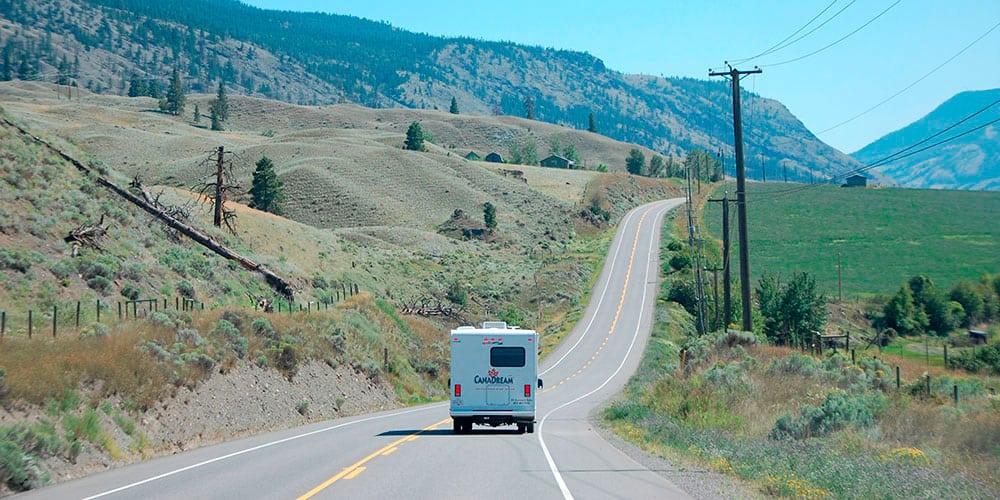What Are RV Air Tanks For?
All diesel and a few gas RV’s and motorhomes will use an air system to power things like the air brakes, the emergency brake, air suspension, and even automatic leveling.
There’s an onboard air compressor that pressurizes two or more air tanks located under the RV towards the front.
Related Product: Add snap on SnapPad Rubber RV Jack Feet (click to view on Amazon) to your RV stabilizers to add grip and eleminate the need for RV blocks.
The compressor maintains air pressure in the tanks from around 90-130 psi so you have enough air for everything that needs it.
There are a few reasons for multiple air tanks on an RV but the main one is mostly a safety precaution.
Not all RV air systems are the same but usually, there is a wet tank, a primary air tank, and a secondary air tank.
Normally each tank is separate from the other so if one gets a leak the other will still be able to run your air system.
Related: Best 12V RV Air Compressor/Tire Inflator With Gauge
Some RV’s use the secondary air tank for things like airbags. In this case, there is most likely a third tank that is completely isolated reserving air for the braking system in case of primary tank failure.
Bleeding the air tanks not only makes sure there is no water in the air system but also checks the connections between the tanks, making sure there are no leaks and the valves between them are working properly.
RV Air System Overview
RV Air Tanks & Air Brakes
The most important job of the RV air tanks is to run the air braking system.
When you press the brake pedal compressed air from an air tank puts pressure on the brake disk or drum to begin the braking process.
As you press down more psi is applied to the brakes and if you press the brake pedal down all the way all the pressure in the air tank will be applied to your brakes.
If your RV doesn’t have ABS (Anit-Lock Braking System) your tires will completely lock up.
When you release the brake pedal the pressure is released and your air tank loses the pressure.
Your compressor has to make up for the lost air and if you pump your brakes too much you could lose a lot of pressure in your tanks.
That’s why it’s better to put even pressure on air brakes rather than pump them when going down long steep declines so you don’t lose the stored compressed air.
RV Air Tanks & The Emergency Brake
The second most important job of your RV air tanks is to engage the emergency braking system.
When there is no pressure in your RV air system large springs engage, apply pressure to your brakes, and lock them up.
When you start up your RV and the compressor turns on it starts to fill the air tanks. When they reach at least 60 psi the springs are pushed back and the emergency brakes are released.
See Also: Best RV Portable Waste Tanks For Black & Grey Water
If you are driving down the road and the “low air pressure” warning comes on you need to pull over as quickly as possible because the emergency air brakes will engage once the pressure gets below 60 psi and your wheels will lock up.
RV Air Tanks & Air Suspension
Air suspension makes for a smooth driving experience in even the largest RVs.
There are many different kinds of air suspensions but they all use airbags that change air pressure as you drive for a smooth, level, controlled drive.
The pressure in the air bags is regulated by the RV air tanks and the compressor. As I said before the air bags are normally run by the secondary air tank because they aren’t as important as the braking system.
If the road you are driving on has a lot of curves and turns your air bags will compress and decompress over and over again and more air from the tanks will be used.
Your RV’s compressor will have to work harder to keep up with the necessary psi. It’s normal for the compressor to be running a lot when on these kinds of roads as opposed to a flat straight road.
If your air compressor is turning on all the time on straight roads you may have a leak somewhere in your air system.
Other Small Sytems Run by RV Air Tanks
The air horn on a large RV uses a small amount of compressed air from the RV air tanks.
You can also use the air tanks to fill the air in your RV tires and even things like inflatables.
If you are inflating something large you should have your engine running so the compressor can be working at full capacity.
Some RV’s even use the air tanks to run the AC.

Why Is Moisture In RV Air Tanks Bad?
There’s always going to be a little water in any air system due to humidity.
Excessive amounts of moisture and water are not good for air tanks or the instruments being run by the compressed air in the tanks because it can cause rust and corrosion in both the tanks and the braking system.
It also increases the wear of the different parts and you may need to replace things more often than normal.
Lots of water in airlines can also freeze. That’s why draining or bleeding air tanks is part of the RV winterizing procedure.
See Also: Best Portable Propane Tabletop Grills & BBQs For Camping
What Does Moisture In RV Air Tanks Mean?
There are three main parts to the air system in an RV. There’s the compressor, the air dryer, and the air tanks.
Moisture in the air is taken in by the air compressor then pushed through the air dryer. The air dryer takes out the water in the air being sent to the air tanks by the compressor.
The air dryer is the key to a healthy RV air system.
The biggest reason manufacturers recommend bleeding your RV air tanks is mostly to check the air drying system to make sure it’s working properly.
If you bleed your air tank and lots of water comes shooting out you have a problem with your air dryer and it needs to be serviced.
The filter on your RV’s air dryer needs to be changed regularly. Make sure to check the RV’s maintenance manual so you know how often you should replace it.
When in hot humid climates like Florida you may need to change it out more often than recommended.
See Also: Best Small RV Dehumidifiers Reviews & Ratings
Why Drain or Bleed RV Air Tanks
I touched on this a little bit before but I’ll say it again. The main reason for bleeding an RV air tank is to test the air dryer to make sure it’s not allowing too much water into your air system.
Lots of water coming from your RV air tanks means a faulty dryer.
There are different opinions about how often you should bleed your air tanks.
There should be a recommendation by the manufacturer but if you don’t have access to that information it’s a good idea to bleed your RV air tanks at least once a week for a few months.
If no or very little moisture is being spat out you can start checking it monthly after a few consecutive weeks of testing.
It’s also recommended to bleed your RV air tanks fully before long term storage and before a long trip.
See Also: Best Heated Water Hoses For RV Campers, Barns & Livestock
How To Drain or Bleed RV Air Tanks
It’s no surprise that there are also a few ways to bleed your RV air tanks. Some procedures go all the way and require draining your air tanks completely while others are just a quick open and close to check for moisture.
I recommend doing the full procedure at least a few times a year, like when winterizing or before a long trip. You can do the quick open and close weekly, monthly or more for a quick air dryer test.
All RV air tanks have a valve on the bottom for draining and bleeding. The way you access this valve can vary.
Most RV’s have a chain that runs from the valve to the outside frame of the RV. The chain is attached to a tag that normally located near the driver’s side front tire and the passenger front tire. These are called “lanyards.”
See Also: How To Find Nearby RV Dump Stations & Fresh Water Fill-Up
If your RV does not have lanyards you will need to crawl under your RV and open the valves by hand.
This procedure can be fairly dangerous especially if all the air gets totally drained from the system and your RV sinks on top of you.
It’s recommended to have the RV up on jacks or the leveling system down when going under the RV. You can also get lanyards installed on your RV air tanks so you don’t have to crawl under all the time.
Most of the time there are three RV air tanks. The supply or “wet” tank (located closest to the air compressor connection), the primary air tank, and the secondary air tank.
The lanyards should be color-coded. Silver for the wet tank, green for the primary, and red for the secondary.
If the lanyards are not color-coded it’s a good idea to look at which tank each one is attached to so you know what tank you are opening.
The Quick RV Air Tank & System Test
When doing the daily, weekly, or monthly quick test all you need to do is pull each lanyard for a few seconds and watch for moisture.
There should be little to none. If there’s a lot you will need to check or service the air dryer.
If you open the valves by crawling under the RV, you only need to open them about halfway.
Make sure you are not directly under the valve when you open it because there will be some heavy pressurized air and possibly water shooting out.
See Also: Best Plastic Rugs & Mats For Outdoor, RV & Patio Use
The Full RV Air Tank & System Test
You can also test for leaks in your RV air system while bleeding them.
The procedure is a little more time consuming than the quick test but it’s a good idea to do this at least a few times a year if not more.
It’s recommended to have your RV supported before doing this test because you will be draining the air system fully and the RV will probably sink.
It’s especially important if you will be under the RV. Jacks are the recommended method of support but some use their RV stabilizers.
- Turn the engine off.
- Both air gauges need to be at 70 psi or less. To get them down to 70 psi pump the brakes to release air in the tanks.
- Turn on the engine and idle on high (1200 RPMs or more) until you hear the air dryer purge out the back of the RV.
- Turn the engine off.
- Turn the key until the electrical is on but do not start the engine.
- Depending on the model of RV you have the lanyards will be located in different places but they will usually be towards the front and on the driver side, passenger side, or both. You need to know which lanyard goes to what tank before starting the procedure.
- Open the supply or “wet” tank first. Let the air empty out of it completely. There should be little to no moisture coming out of the tank. (Of all the air tanks the “wet” tank should have the most moisture inside if any.)
- Check the gauges inside your RV. After draining the “wet” tank there should be little to no change in pressure. If they read zero or have decreased significantly there may be a problem with the “check valve” between the wet and the primary tank.
- Open the primary tank. Let it drain and empty completely. There should be little to no moisture coming out of the tank.
- Check the air gauges again. On some air systems, the rear air gauge will read zero, but the front gauge won’t read zero and still have some air in it. No matter what kind of air system your RV both gauges should not be at zero yet, there should be a little air left in at least one. If they are both at zero there may be a problem with the “check valve” between your primary and secondary RV air tank.
- Open the secondary air tank. Let it drain and empty completely. There should be little to no moisture coming out of the tank.
- Check the air gauges, they both should now be at zero.
- As an extra check for moisture open all the drain valves one more time to check and make sure all the moisture was released (there may be some that was unable to be released from all the compressed air flowing out.)
- Make sure all the valves are fully closed again. If there were no problems, your air system is in good condition.
- Turn on your engine and allow the compressor to fill the RV air tanks to full capacity again (around 125-130 psi).

Final Thoughts About Bleeding RV Air Tanks
The RV air system is a very important part of any diesel or large RV. The air tanks are what give the entire system the stored pressure all the parts need to function.
Keeping your air tanks in good working condition is necessary for an RV to run safely. Bleeding the tanks to make sure no water is compromising the system should be a daily or weekly procedure.
And doing a full RV air tank bleed at least a few times a year or even monthly, to make sure the check valves are working properly could save you in an emergency.
See Also: Best Folding Camping Chairs For RV & Camp Use Reviewed
Catching problems with your RV air tanks early on is key to driving an RV safely.
If your compressor, air dryer, and air tanks aren’t working properly your air brakes, emergency brake, air suspension, and even your horn could be in danger of not functioning.
That’s why bleeding RV air tanks is so important.
You should know how the air system in your RV works before you even drive it. There are lots of resources online and there are courses you can take.
Countries like Canada require all RV owners to take a course on air brakes and air systems before they can drive.
They have a detailed and informative free online handbook that has everything you need to know about air supply subsystems if you want to learn more. (Click here to check it out)
Have any more questions about bleeding RV air tanks or RV air systems? Leave a comment below.


Great article thanks
I can’t believe there’s no youtube video covering this topic in full. There are a few, but none really showing you through lanyards location and what you should be looking for when doing this test.